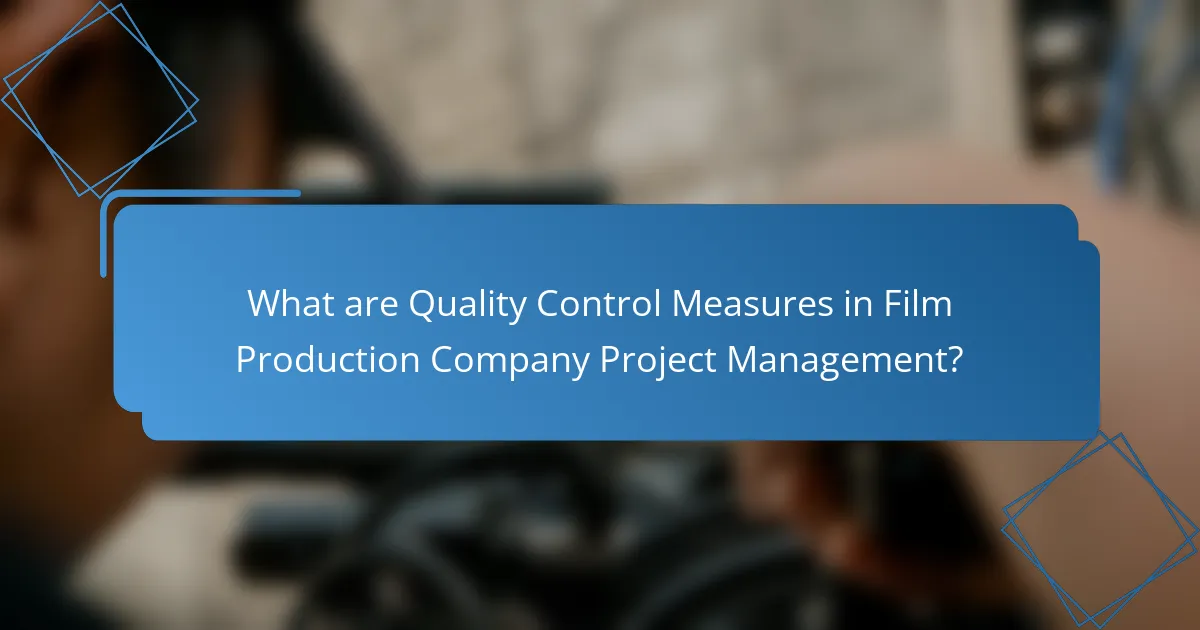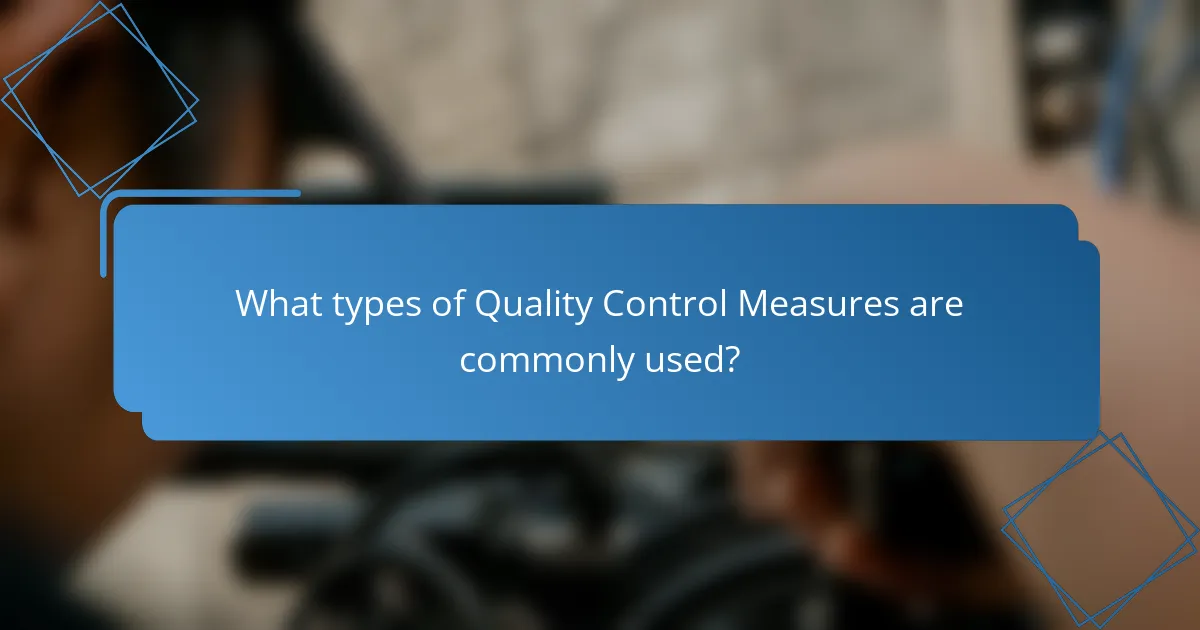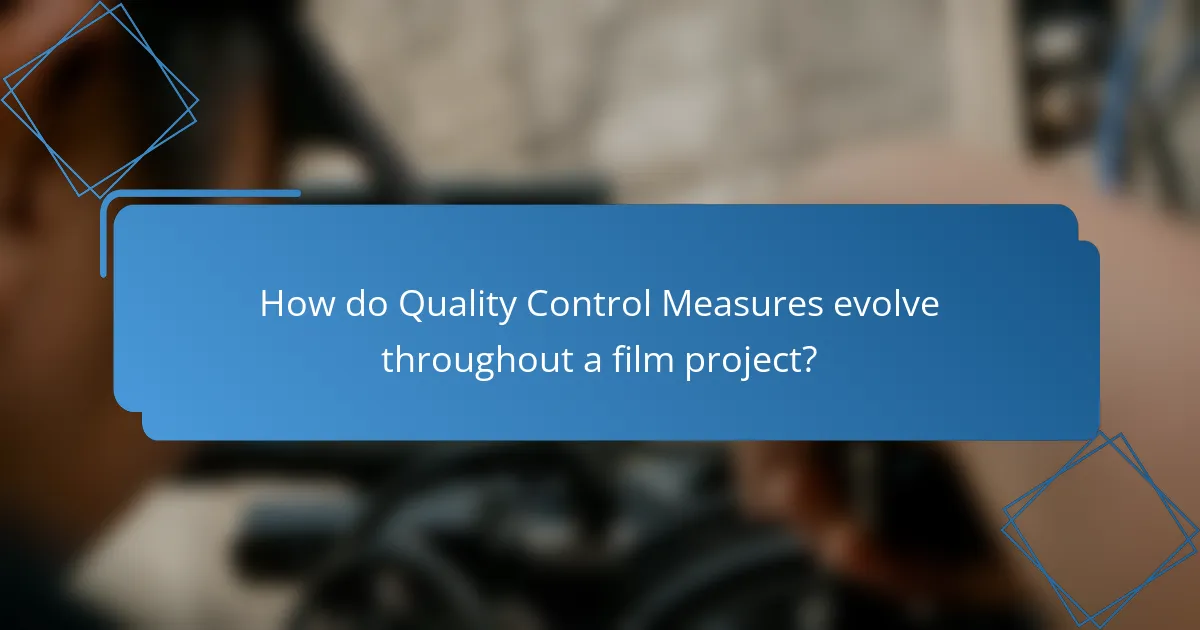Quality control measures in film production company project management are essential for ensuring that the final product meets established standards. These measures include regular reviews of scripts, casting, production schedules, and technical aspects such as sound and visual effects. The article outlines common quality control practices like inspections, testing, and audits, which help maintain high standards throughout all production phases. It emphasizes the importance of feedback loops for continuous improvement and compliance with industry regulations. By implementing these strategies, film production companies can significantly reduce errors, enhance production quality, and ultimately improve audience satisfaction and commercial success.

What are Quality Control Measures in Film Production Company Project Management?
Quality control measures in film production company project management ensure the final product meets established standards. These measures include regular reviews of scripts, casting, and production schedules. Quality assurance processes involve monitoring technical aspects like sound and visual effects. Feedback loops are established to address issues promptly during filming. Post-production quality checks assess editing, sound mixing, and color grading. Compliance with industry regulations is also a key component of quality control. Implementing these measures can significantly reduce errors and enhance overall production quality. Studies show that effective quality control can improve audience satisfaction and commercial success.
How do Quality Control Measures ensure project success?
Quality control measures ensure project success by systematically monitoring and evaluating project processes and outcomes. These measures help identify defects and areas for improvement early in the project lifecycle. By implementing quality standards, teams can maintain consistency and meet client expectations. Regular inspections and testing verify that deliverables align with specified requirements. Data-driven analysis of project performance allows for informed decision-making. This proactive approach reduces risks and enhances efficiency. Studies show that projects with robust quality control practices have a higher likelihood of meeting deadlines and staying within budget. Overall, effective quality control is essential for achieving project objectives in film production.
What are the key components of Quality Control Measures?
The key components of Quality Control Measures include planning, monitoring, and evaluation. Planning involves setting quality standards and objectives for production. Monitoring focuses on assessing processes and outputs against these standards. Evaluation reviews the results to ensure compliance and identify areas for improvement. These components work together to maintain high-quality production outcomes. Implementing these measures can lead to improved efficiency and reduced errors in film production.
How do these components interact within film production?
Film production components interact through a structured collaboration process. Each component, such as script, direction, cinematography, and editing, plays a crucial role. The script serves as the foundation, guiding the direction and cinematography. Direction translates the script into visual storytelling, while cinematography captures the visuals. Editing then assembles these visuals into a coherent narrative. Quality control measures ensure that each component aligns with the project’s vision. Regular reviews and feedback loops facilitate adjustments and improvements. This interaction fosters a cohesive final product that meets quality standards.
Why is Quality Control important in film production?
Quality control is crucial in film production to ensure the final product meets industry standards. It helps identify and rectify issues during the filmmaking process. This process includes reviewing footage, sound quality, and editing consistency. Effective quality control can prevent costly reshoots and delays. According to a study by the American Film Institute, films with rigorous quality control have a higher success rate at the box office. Quality control also enhances audience satisfaction and brand reputation. By maintaining high standards, filmmakers can foster trust with stakeholders and investors.
What risks does Quality Control mitigate in film projects?
Quality Control mitigates several risks in film projects, including budget overruns, schedule delays, and quality issues. Effective Quality Control ensures that the project adheres to financial constraints. It identifies potential overspending early in the process. This allows for timely adjustments to the budget. Additionally, Quality Control helps maintain the production schedule. It identifies delays in the workflow and addresses them promptly. Quality Control also ensures the final product meets quality standards. This reduces the risk of rework and reshoots, which can be costly. By implementing Quality Control measures, film projects can significantly minimize these common risks.
How does Quality Control impact the final product quality?
Quality control directly influences final product quality by ensuring that each stage of production meets established standards. It involves systematic processes to identify defects and inconsistencies. By implementing quality control measures, a film production company can detect issues early. This early detection reduces costly reworks and enhances overall efficiency. According to a study by the Project Management Institute, organizations with strong quality control practices see a 20% increase in project success rates. Additionally, consistent quality control leads to higher customer satisfaction and brand reputation. Therefore, effective quality control is essential for achieving high-quality final products in film production.

What types of Quality Control Measures are commonly used?
Commonly used quality control measures include inspections, testing, and audits. Inspections involve examining products or processes to ensure they meet specified standards. Testing assesses the performance and quality of materials or components. Audits evaluate compliance with established procedures and regulations. Statistical process control monitors production processes to identify variations. Quality assurance ensures that processes are in place to maintain quality. Each measure plays a vital role in maintaining high standards in film production projects.
How do different Quality Control techniques apply in film production?
Quality control techniques in film production ensure that the final product meets industry standards and audience expectations. Techniques include script reviews, location scouting, and equipment checks. Script reviews focus on narrative coherence and dialogue quality. Location scouting assesses visual aesthetics and logistical feasibility. Equipment checks verify that cameras, lighting, and sound gear function properly.
Post-production quality control involves editing, sound mixing, and color grading. Editing ensures continuity and pacing. Sound mixing balances dialogue, music, and effects for clarity. Color grading enhances visual appeal and consistency. Regular feedback loops with stakeholders help identify issues early.
These techniques collectively minimize errors and enhance the overall quality of film productions. Quality control is crucial for maintaining a film’s artistic integrity and commercial viability.
What is the role of inspections in Quality Control?
Inspections play a crucial role in Quality Control by ensuring that products meet specified standards. They involve systematic evaluations of processes, materials, and finished goods. Inspections help identify defects or deviations early in the production process. This early detection minimizes waste and reduces costs associated with rework. Regular inspections contribute to maintaining consistency and reliability in production. They also provide documentation that supports compliance with industry regulations. In film production, inspections ensure that technical and artistic standards are met throughout the project lifecycle. Ultimately, inspections enhance overall product quality and customer satisfaction.
How do testing and feedback contribute to Quality Control?
Testing and feedback are essential components of Quality Control. They help identify defects and areas for improvement in film production. Testing involves evaluating various aspects of the production, such as script quality, cinematography, and editing techniques. Feedback from team members and audiences provides insights into the effectiveness of these elements. This iterative process ensures that any issues are addressed before final release. Research shows that companies utilizing structured testing and feedback mechanisms see a 30% increase in overall production quality. By continuously refining processes based on feedback, film production companies can enhance their final products significantly.
What are the best practices for implementing Quality Control Measures?
Establishing clear quality standards is a best practice for implementing Quality Control Measures. These standards define the expected level of quality for all projects. Regular training for team members ensures they understand these standards. Consistent monitoring of processes helps identify deviations from quality expectations. Utilizing checklists can streamline quality assessments during production phases. Gathering feedback from stakeholders enhances the quality control process. Documenting all quality control activities provides a reference for future projects. Finally, conducting regular audits can improve adherence to quality standards.
How can technology enhance Quality Control in film projects?
Technology enhances Quality Control in film projects by streamlining processes and improving accuracy. Digital tools enable real-time monitoring of production quality. Software can track equipment performance and ensure adherence to technical standards. Automated systems reduce human error during editing and post-production. Cloud storage allows for secure and accessible data management. Collaboration tools facilitate communication among team members, ensuring everyone is aligned. Analytics software can evaluate performance metrics and identify areas for improvement. These advancements lead to higher quality outputs and more efficient workflows.
What training is necessary for effective Quality Control?
Effective Quality Control requires training in several key areas. Employees should receive training in quality management principles. This includes understanding quality assurance and quality control processes. Familiarity with industry standards is also essential. Training should cover specific tools and techniques used in quality control. This may include statistical process control and inspection methods. Additionally, employees should be trained in problem-solving techniques. This helps in identifying and addressing quality issues promptly. Regular training updates are necessary to keep staff informed of new practices. Overall, comprehensive training enhances the effectiveness of Quality Control in film production.

How do Quality Control Measures evolve throughout a film project?
Quality control measures evolve throughout a film project by adapting to different production phases. In pre-production, measures focus on script analysis and budgeting accuracy. This ensures that potential issues are identified early. During production, quality control includes regular monitoring of filming techniques and equipment functionality. This helps maintain consistency in visual and audio quality. Post-production involves rigorous editing and sound mixing checks. These ensure that the final product meets industry standards. Throughout all stages, feedback loops are established for continuous improvement. This iterative process helps in addressing any emerging issues effectively.
What stages of film production require specific Quality Control Measures?
The stages of film production that require specific Quality Control Measures include pre-production, production, and post-production. During pre-production, scripts, budgets, and schedules must be meticulously reviewed for accuracy. This ensures that the project aligns with creative and financial goals.
In the production stage, continuous monitoring of filming quality is essential. This includes checking audio, lighting, and camera work to maintain consistency. Quality control in this phase prevents costly reshoots.
Post-production also demands thorough quality checks. Editing, sound design, and visual effects are evaluated for coherence and quality. Ensuring that the final product meets industry standards is crucial for distribution.
These measures are vital to maintain the integrity and success of the film project.
How do Quality Control Measures adapt to different production phases?
Quality control measures adapt to different production phases by implementing specific protocols tailored to each stage. In pre-production, measures focus on script reviews and casting assessments. These steps ensure alignment with project goals and quality expectations. During production, real-time monitoring of equipment and performances is essential. This ensures that any issues are addressed immediately to maintain quality. In post-production, quality control shifts to editing and sound design reviews. This phase emphasizes finalizing the product to meet industry standards. Each phase utilizes distinct metrics and criteria to assess quality effectively. For example, during production, adherence to shooting schedules and technical specifications is critical. In contrast, post-production focuses on visual and audio fidelity. This structured approach ensures that quality is consistently maintained throughout the entire production process.
What role do stakeholders play in Quality Control during production?
Stakeholders play a critical role in Quality Control during production. They include producers, directors, and clients who set quality standards. Their involvement ensures that project objectives align with quality expectations. Stakeholders provide feedback throughout the production process. This feedback helps identify issues early and allows for timely corrections. Their insights contribute to maintaining consistency in quality. Engaging stakeholders can enhance collaboration and communication among team members. Research indicates that projects with active stakeholder involvement exhibit higher quality outcomes.
What challenges do film production companies face in Quality Control?
Film production companies face several challenges in quality control. These include maintaining consistent visual and audio standards throughout the production process. Coordination among various departments can lead to miscommunication, affecting the final output. Budget constraints often limit the ability to implement extensive quality checks. Time pressures during production can result in rushed decisions that compromise quality. Additionally, the subjective nature of film can lead to differing opinions on what constitutes ‘quality.’ Tracking changes and revisions can be cumbersome, leading to inconsistencies. Finally, evolving technology requires constant adaptation to new quality control methods.
How can companies overcome common Quality Control obstacles?
Companies can overcome common Quality Control obstacles by implementing standardized procedures. Standardization ensures consistency in processes and outputs. Training employees on these procedures enhances their understanding and execution. Regular audits can identify deviations from standards early. Utilizing technology for real-time monitoring improves accuracy in quality assessments. Feedback loops allow for continuous improvement based on performance data. Collaborating with suppliers ensures that materials meet quality expectations. Engaging stakeholders in quality discussions fosters a culture of accountability. These strategies collectively enhance quality control effectiveness in film production projects.
What are the consequences of neglecting Quality Control?
Neglecting Quality Control can lead to significant negative outcomes in film production. The primary consequence is the release of substandard content. This can damage a production company’s reputation and lead to financial losses. Poor quality can result in negative audience reviews and reduced box office performance. Additionally, it may lead to increased rework and production delays. Inefficiencies in the production process often arise from a lack of quality oversight. Furthermore, neglecting quality can result in compliance issues with industry standards. Ultimately, these consequences can hinder a company’s long-term success and viability in the competitive film industry.
What practical tips can improve Quality Control Measures in film production?
Implementing checklists can enhance Quality Control Measures in film production. Checklists ensure that all necessary steps are completed during filming and post-production. Regularly reviewing these checklists helps maintain consistent quality. Utilizing software for project management can streamline communication and task assignments. This software can track progress and identify issues early. Conducting regular team meetings fosters collaboration and addresses concerns promptly. Training staff on quality standards is crucial for maintaining production integrity. Setting clear expectations for deliverables helps align team efforts. Finally, soliciting feedback from crew members can uncover areas for improvement.
Quality Control Measures in Film Production Company Project Management focus on ensuring that the final film product adheres to established quality standards throughout the production lifecycle. The article outlines the importance of systematic monitoring, evaluation, and feedback mechanisms in identifying defects and improving processes, which ultimately leads to enhanced audience satisfaction and commercial success. Key components include planning, inspections, testing, and stakeholder involvement, while challenges such as budget constraints and miscommunication are also addressed. The role of technology and best practices for implementing effective quality control measures are discussed, emphasizing their significance in mitigating risks and achieving high-quality outcomes in film projects.